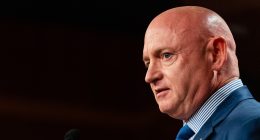
The U.S. economy appears to have grown robustly in the final quarter of 2021 but recently lost momentum, economists say, with business activity undermined by pandemic-induced shortages of supplies and workers.
The Commerce Department will offer a broad snapshot of the world’s largest economy at 8:30 a.m. ET Thursday. Economists estimated the agency will report that gross domestic product, the broadest measure of goods and services, expanded at a 5.5% annual rate in the fourth quarter, according to a Wall Street Journal survey.
That would mark the sixth consecutive quarter of growth since the pandemic caused a short but severe recession in spring 2020. Output grew at a 2.3% rate in the third quarter of last year, according to previously released government statistics.
Output likely grew strongly in the fall and early winter as last summer’s Covid-19 Delta variant faded, schools and businesses more fully reopened, vaccinations rose and consumers spent down their high level of savings.
As a whole, 2021 likely marked one of the strongest economic rebounds in years, if not decades. Economists surveyed by the Journal expect that output grew just above 5% in 2021, when measuring the fourth quarter over the same period a year earlier. That would mark the strongest growth in a calendar year since 1984, when output rose 5.6%.
But the economy appears to have cooled in recent weeks because of the pandemic’s Omicron variant, which emerged in South Africa in late November and spread to the U.S. and around the globe. The variant has sent many sick workers home; caused some schools, universities and businesses to close temporarily; and prompted some cities to restrict in-person shopping to those who are masked and vaccinated.
Data from Affinity Solutions, a firm that tracks consumer spending, shows that overall, consumers continued to spend in the first half of January, said Chief Executive Jonathan Silver. While spending growth slowed, it hasn’t fallen, a sign consumers aren’t too spooked and should keep output growing, he said.
“They’re not viewing Omicron as much of a threat,” Mr. Silver said. “They’re willing to spend. There’s a perception that they have disposable income because of higher employment and accumulated savings over the pandemic. I think people are getting a little more comfortable and we expect that to continue.”
While economists and health officials expect the effects of the variant to fade in coming months, the illness is for now restraining the economic recovery.
Strum Contracting Co., a Baltimore-based welding and fabrication construction company, had been until early this month working to improve a port in Sparrows Point, south of Baltimore. Then an outbreak of Covid-19 cases among workers caused the company to shut down the project for a week, said company CEO Teaera Strum. The shutdown cost the company about $18,000 in lost revenue, she said.
SHARE YOUR THOUGHTS
How might the fourth-quarter GDP numbers affect your outlook for U.S. economic growth this year? Join the conversation below.
“When you’re having to quarantine entire crews, that puts you behind schedule,” said Ms. Strum, who added that the company has also struggled to fill openings for welders and a project manager. “Because we do a lot of state and federal work, we still have hard deadlines. So Covid or not, we still have to meet those deadlines.”
Strum’s struggles are representative of a broader problem in the economy: Demand for companies is strong, but supplies—whether of goods or workers—are running tight. Those shortages are stoking inflation.
The Federal Reserve signaled on Wednesday it would press ahead with lifting interest rates this year, starting in March, to rein in inflation while hoping to keep the economy growing steadily.
“The path of the economy continues to depend on the course of the virus,” the central bank said in a written statement. “Progress on vaccinations and an easing of supply constraints are expected to support continued gains in economic activity and employment as well as a reduction in inflation. Risks to the economic outlook remain, including from new variants of the virus.”
The forecasting firm IHS Markit projects that output will grow at a 1.5% annual rate in January through March. That would mark the weakest quarter of growth since the recovery began in mid-2020. The company gave an early peek at economic growth this week when it reported that its index of U.S. services and manufacturing activity—covering most of economic activity—slowed sharply.
Output is expected to pick up later this year as Omicron fades, supply problems ease and workers return to work, economists say. Perhaps the biggest factor driving growth is consumer spending, which showed signs of slowing in December. Still, households continue to shop as more people gain jobs and raises and as their savings—boosted by federal stimulus efforts—remain above pre-pandemic levels, economists say.
—Bryan Mena contributed to this article.
Write to Josh Mitchell at [email protected]
Copyright ©2022 Dow Jones & Company, Inc. All Rights Reserved. 87990cbe856818d5eddac44c7b1cdeb8








